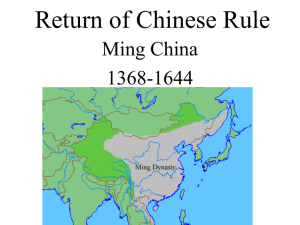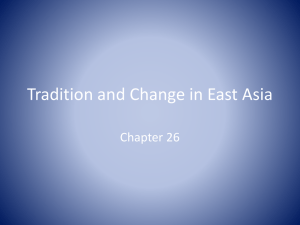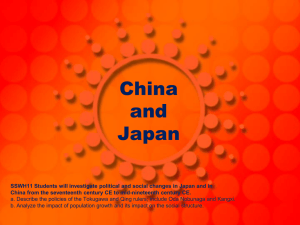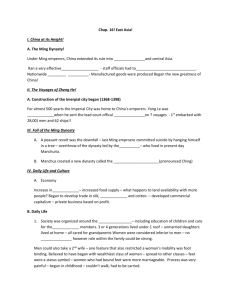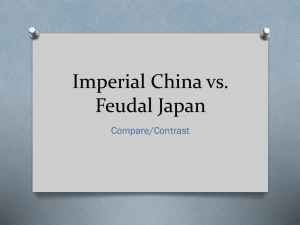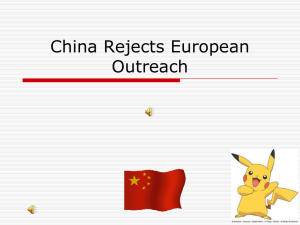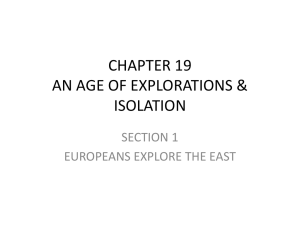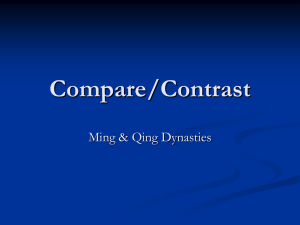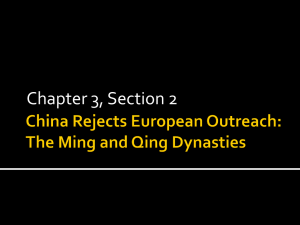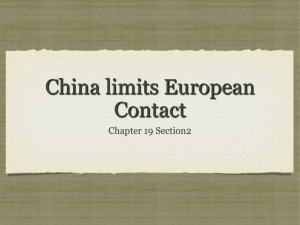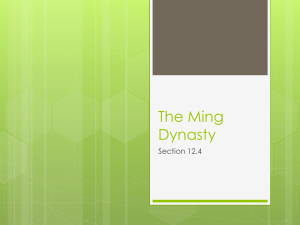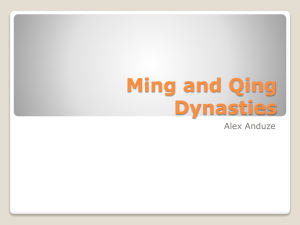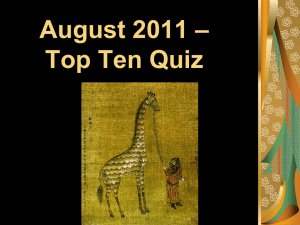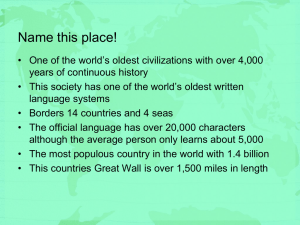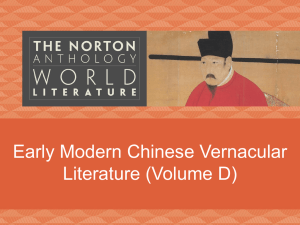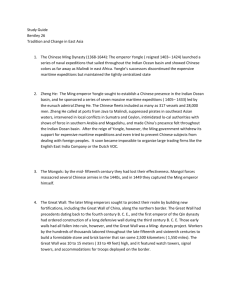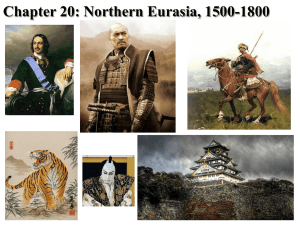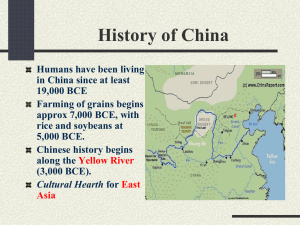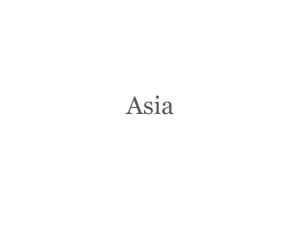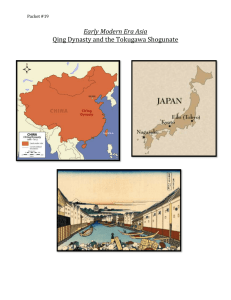Chapter 27 Tradition and Change in East Asia
advertisement
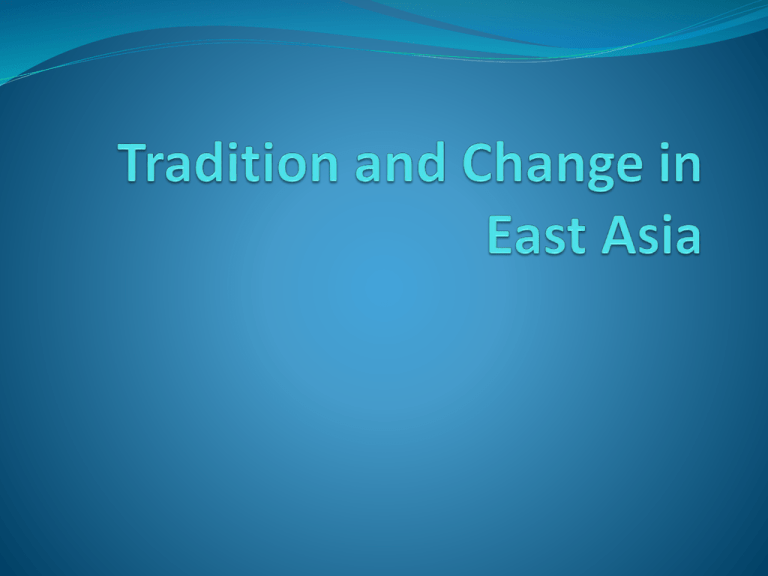
Before you get started East Asia is a frequent choice for compare and contrast and change-over-time questions on the national exam. This chapter discusses changing political structure, social organization, economic development, and religious tradition in China and Japan. The Quest for Political Stability When the Yuan Dynasty came to an end in 1368, the Ming and then the Qing rulers went to great lengths to erase all remains of the Mongol cultural elements and to restore Chinese tradition. They built a powerful imperial state, revived and staffed the civil service system with Confucian scholars, and promoted Confucian social precepts. Produced a deeply conservative government. Successful for more than 500 years. Quest for Political Stability The Ming Dynasty Ming actually means “Brilliance” Hongwu – Founder of the Ming dynasty who hoped to return China to traditional forms of Chinese government after 300 years of Mongol rule. Relied on the mandarins (travelling government officials) and eunuchs (court officials who acted in the name of the courts) Promoted all things Chinese, revived Confucian ideals, and eradicated most leftover Mongol influences Rebuilt and extended the Great Wall and other defenses to protect against Mongols and other Northern Invaders Eventually, internal disunity caused their fall in 1644 and the invading manchus (Qing) gained control The Quest for Political Stability The Qing Dynasty Manchus – Began as pastoral nomads in a region of China north of Korea, frequently traded and clashed with the Chinese since the Qin dynasty. United under the leadership of Nurhaci in the early seventeenth century and defeated the Ming Dynasty (1644). Conquering Manchus were careful to preserve their own ethnic and cultural identity. Example – Outlawed intermarriage between Manchu and Chinese, enforced Manchu hairstyles, etc. Eventually drew to a close in the early twentieth century for many of the same internal reasons as the Ming Dynasty. The Quest for Political Stability The Son of Heaven and the Scholar-Bureaucrats “Son of Heaven” – Chinese belief that the emperors of the Ming and following dynasties were designated by heaven to rule. They lived very sheltered and protected lives Scholar-gentry Most of the governing affairs of China were left to well educated men who had passed a series of extremely difficult exams. Economic and Social Changes While the Ming and Qing emperors succeeded in their goal of restoring and maintaining Chinese traditional hierarchy and patriarchy, they could not prevent the impact of new food crops from abroad and the impact of global trade on the Chinese economy which produced great wealth, urban growth, and an ensuing boom in population. Economic and Social Change The Patriarchal Family Chinese families hierarchal and authoritarian Duty to one’s father or oldest male emphasized Filial Piety (Duty to one’s family) emphasized Women Far less opportunities than males Expected to be subservient and quiet Infanticide Footbinding Ritual suicide following a husband’s death Economic and Social Change Population Growth and Economic Development Introduction of American food crops obtained by Europeans led to more stable food sources and large population growth. China began restricting trade significantly during the Ming and Qing dynasties. Also developed a resistance to technology innovations fearing that it may lead to insurrection. Initially it was successful, but in the end China suffered because of this. Economic and Social Change Gentry, Commoners, Soldiers and Mean People TOP of Social Hierarchy -Emperor and his family Then, Scholar-bureaucrats and gentry Then, Commoners (artisans, workers, peasants, merchants) BOTTOM of Social Hierarchy – Soldiers and “mean people” (slaves, etc) The Confucian Tradition and New Cultural Influences Although Confucian traditions remained, changing demographics and rising urban populations encouraged the development of new cultural patterns: urban culture and European traditions. Neo-Confucianism and Pulp Fiction Neo-Confucianism – Combination of the moral, ethical, and political values of Confucianism with the logical rigor and intellectual power of Buddhism. Became very popular in the Ming and Qing dynasties because of its emphasis on filial piety, self-discipline, and obedience. The Confucian Tradition and New Cultural Influences The Return of Christianity to China The plague and the collapse of the Yuan dynasty virtually wiped Christianity away from China. Returned in the sixteenth century with Catholic and Jesuit missionaries who attempted unsuccessfully to convert large numbers of Chinese to Christianity. Unintended consequence of the European missionary attempts was that Europe became more exposed to China. The Unification of Japan After nearly four centuries of civil disorder, political unification emerged in Japan in the late sixteenth and early seventeenth centuries. Like their Chinese neighbors, Japanese shoguns would promote the idea of traditional values to lay the foundation for long-term political and social stability, but ultimately be unable to withstand foreign influences or restrict commercial interactions. The Unification of Japan The Tokugawa Shogunate Shoguns – Military governors who actually ruled Japan through a series of retainers who supplied them with military support in exchange for political rights and landed estates. By the sixteenth century the Tokugawa Shogunate emerged as the dominant shogun (after a civil war) Worried about European influence, the Tokugawa attempted to maintain political stability by enforcing strict isolationist policies. Unsuccessful in fully achieving isolation. The Unification of Japan Economic and Social Change New crop strains, improved water control and irrigation, and the use of fertilizer resulted in dramatically increasing rice yields. Neo Confucianism was the official ideology of the Tokugawa, although many held onto the Shinto beliefs fearing the outside influence of China City life changed (teahouses, theaters, etc) and cities experienced significant middle class growth as a result. The Unification of Japan Christianity and Dutch Learning Tokugawa shogunate implemented harsh anti-Christian campaigns when Christianity started to gain converts in Japan. Fear that European Christianity to disrupt stability and by the end of the seventeenth century tens of thousands of Japanese Christians had been tortured and killed under Tokugawa policies. Dutch As trade with the Dutch continued European influences in art, medicine, technology and astronomy started to trickle into Japanese culture by the mid-eighteenth century.
